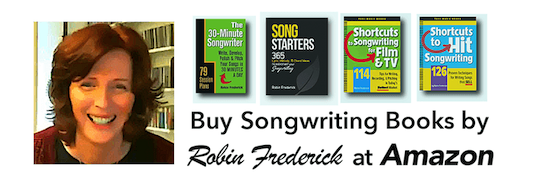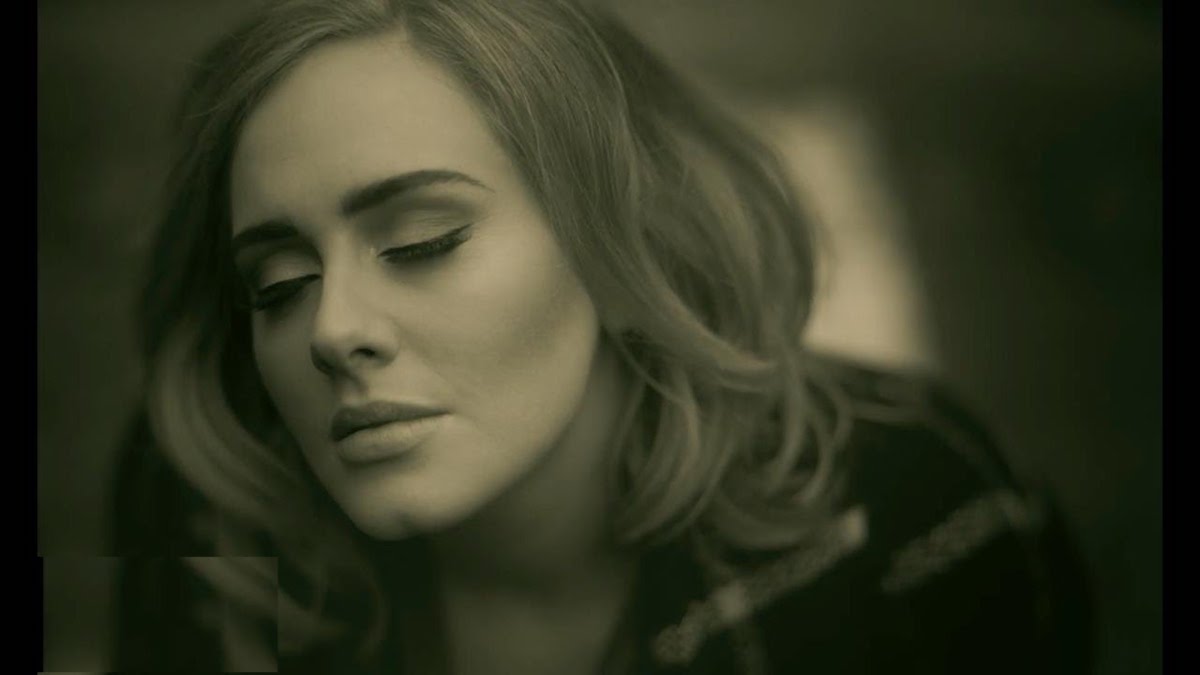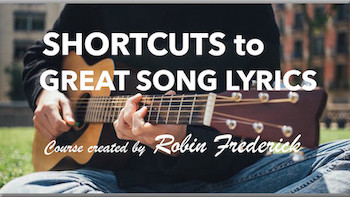
I often suggest in my songwriting posts that you learn to sing and play (or just sing ) successful songs. But why is that so important? Because you miss so much when you don’t. It’s like the difference between zooming down a highway at 80 mph versus rolling slowly along with your head stuck out the window.
When you slow down, you notice things… road signs, blue sky. You feel every bump in the road and the smells on the breeze. At 80 miles-per-hour you can feel the emotional rush; when you slow down, you can learn what the rush is made of.
I thought it might be fun for you and I to slow down and go through the process of learning to play and sing a hit song together. I chose “Hello” by Adele because, as I listen to it, the 80 mile-per-hour experience is pretty good, and something tells me that if I slow down and take a closer look, there might be some good songwriting tips I could use to create that experience in songs of my own. So, let’s take it for a drive.
“HELLO”
Artist: Adele
Writers: Adele Adkins, Greg Kurstin
FIRST, listen. Play the song a couple times. Don’t think about songwriting. Just react to the song as an average listener would. Notice the places where your interest increases or lessens, where your energy lifts or falls.
After listening, print out the lyrics. You can find them here.
THEN… play the recording and hum or sing along with the track, filling in the words as soon as you can. Don’t worry if your vocal is off pitch or you can’t reach the notes. (Hey, it’s Adele!) Just sing. If the chorus is too high, try an octave lower. The idea is to get a feel for line lengths, the motion of the melody, and how the words fit into it.
While you sing along, tap your foot or clap to the underlying, steady beat. This is important. You want to embed the feel of the melody and lyrics weaving in and out of the underlying, steady beat.
MELODY – VERSE
So, here are a few songwriting tricks Adele uses in the verse that I noticed as I sang along. Sing it and see if you notice them, too.
Verse 1
Hello, it’s me
I was wondering if after all these years you’d like to meet
To go over everything
They say that time’s supposed to heal ya but I ain’t done much healing.
1. MIX OF PHRASE LENGTHS – Notice the mix of short melody lines with much longer ones. The second and fourth lines keep going and going and going. Listeners aren’t expecting that. It surprises them and keeps things interesting. It also avoids a long pause at the end of the second and fourth lines, giving the melody more momentum. Note to self: Use that.
2. REPETITION – Notice that the melody repeats on Lines 1 and 3, and on Lines 2 and 4. Repetition makes a melody easy to remember but see-sawing back and forth like this can start to feel predictable. This melody uses a clever lyric trick to make the melody repetition less obvious…
3. UN-COUPLING LYRICS & MELODY – On Line 2 the melody and lyric phrases seem to start and end together: “I was wondering if, after all these years, you’d like to meet…” But the LYRIC thought continues into Line 3 – “to go over everything” – while the MELODY says, “Nope, this is a new line.”
This is a terrific songwriting technique for giving a generic or predictable melody more listener appeal. Stretch a lyric thought from the end of one melody line into the beginning of the next. Or start a new lyric thought in the middle of a melody line. It throws the listener off balance and gives your melody a major facelift. Note to self: Definitely use that!
Now, play the second verse, starting with “Hello, can you hear me?” See if you can spot the same phrasing twists being used there.
Songwriting techniques to try:
• Use a pattern of phrase lengths.
• Use repetition to make your melody easy to remember.
• Try un-coupling the lyric from the melody phrases.
Sing along with these verses a few times to really get a feel for the songwriting tools.
MELODY – CHORUS
Now listen to the first half of the chorus and read or sing along.
1. USE A DIFFERENT PATTERN OF REPEATS – In the chorus, the first two lines have the same melody, then the next pair of lines has a different melody. This is a different pattern of repeats from the see-saw pattern in the verse.
Chorus Pair #1
Hello from the other side
I must’ve called a thousand times
Chorus Pair #2
To tell you I’m sorry for everything that I’ve done
But when I call you never seem to be home
2. CHANGE LYRICS AS MELODY REPEATS – Notice how Adele changes the lyrics on the repeated melody lines. That’s a very effective way of maintaining interest. The lyric gives listeners more to think about, while the repeat of the melody makes this big chorus melody easy to remember.
3. CREATE CONTRAST IN MELODY – Now, here’s the bazinga! Notice how different the first pair of melody lines is from the second pair. The first two lines are pretty straightforward rising lines that emphasize the basic, strong beats (the 1-2-3-4).
The third and fourth lines start with up and down leaps that emphasize the weak beats (the “and” between beats), then wrap up with a descending line.
Adele and her cowriter create contrast between straightforward lines with emphasis on the strong beats versus syncopated lines with unexpected emphasis. Clearly defined and really effective contrast! Note to self: I have GOT to try that!
Listen again to the whole chorus and check out the pairs of repeated melody lines and the contrast in melody between the pairs.
Songwriting techniques to try:
• Repeat a melody while changing the lyric.
• Create contrast using pitch, syncopation, and note lengths.

LYRICS
POINT OF VIEW – This song is clearly written from the singer’s point of view and it’s taking place right now right in front of the listener. It sounds like Adele is speaking directly to another person (or their voice mail). It has that “tabloid” quality, the sense of watching or listening in on someone else’s personal life as it’s happening. Listeners love that.
KEEP YOUR LISTENER IN MIND – Even as we listen in on this intimate phone call, we’re being given enough information to understand why the singer feels the way she does, but not so much detail that the song gets bogged down. Before you read the next paragraph, read through the lyric yourself and look at how it delivers information without appearing to.
… I’m waiting while you do that. 🙂
Phrases like “after all these years,” “I ain’t done much healing” “I’m sorry for everything that I’ve done,” and “it clearly doesn’t tear you apart anymore” tell us all we need to know about the emotional situation. We don’t need to know exactly what happened, only that it’s something she still regrets even after years have passed.
When writing a song about an emotional situation or event that happened to you, try to maintain a balance. You don’t need to give listeners every detail, just the ones they need to know in order to understand why you feel as you do. Note to self: Remember that.
FOCUS – From the opening line of this song, Adele’s aim is true. She doesn’t veer off the storyline or away from the situation. This takes discipline and a clear idea of what you’re writing about.
When an inspired verse or chorus comes to you, it can be the start of a great song or it can walk you right into a dead end of confused ideas. Be sure you ask yourself early on what your song is about and look for lyric lines that support your central story or idea.
For more on writing from an inspired verse or chorus, read What Are You Really Writing About?
RHYMES – Hmmm… There are some lines where Adele makes no attempt to rhyme. In Verse 2, for example, the final line (“…where nothing ever happened”) doesn’t rhyme with any previous line.
More importantly, at the very end of the chorus, a place where we usually put a strong rhyme to create a sense of completion, the word “anymore” isn’t a rhyme. “Heart” and “apart” rhyme, which seems to be enough to give the chorus some closure.
Lack of rhymes can add to the conversational quality of a lyric. It can sound raw and honest, as if the singer just thought of it on the spot. But can you get away without rhyming?
Adele has a real knack for writing and singing very emotional songs that sound as if she’s speaking to someone that very moment. It’s difficult to know whether another singer will be able to finesse something like that.
So I recommend caution when writing songs to pitch to other artists. Play it safe. Give your payoff line (the last line of your chorus) a strong rhyme. Use near rhymes (vowel rhymes) in your verses to give yourself plenty of room for creativity. Look over the lyrics to a few contemporary hits in your genre for ideas on how to do it.
Songwriting techniques to try
• Choose a point of view that lets listeners feel they’re inside the situation
• Maintain focus throughout your lyric. Know what you’re writing about.
• A relaxed rhyme scheme can make a lyric feel spontaneous and believable.
GENRE (What is a genre?)
The thing that strikes me about this song is how radio-friendly it is. It has the big chorus that characterizes many Pop and Adult Contemporary hits. The melody has a mix of repetition and variation that makes it easy to remember but keeps it interesting – another plus for radio. The lyric is revealing and emotional. The song went to #1 on Billboard’s Pop Top 40 and Adult Contemporary and was a huge international hit. I’d keep this song in mind if I’m thinking of writing a mid-tempo ballad for Pop or Adult Contemporary radio.
STRUCTURE
This song structure of “Hello” looks like…
VERSE / PRE-CHORUS / CHORUS
VERSE / PRE-CHORUS / CHORUS
SORT OF BRIDGE
CHORUS
INTRO – Check out that very short intro. Just two measures, four chords. I expected it to repeat but it didn’t. If you’re writing a ballad for radio, it’s a good idea to get to the vocal as quick as you can.
VERSE – The song opens with a double verse. (“Hello, it’s me…” and “Hello, can you hear me?”) After the first chorus, there’s a single verse (“Hello, how are you?”).
PRE-CHORUS – There’s a short, two-line pick-up to the chorus that adds anticipation. (Pre-chorus #1: “There’s such a difference between us / And a million miles.” Pre-chorus #2: It’s no secret that the both of us / Are running out of time.” ) It’s so short it almost doesn’t feel like a pre-chorus, but it adds a little bump of energy so I’m calling it that. Feel free to disagree.
Both pre-choruses are followed by a pause at the end, just before the chorus drops. The pause seems to last for five beats because the line before it is short, but there’s no change in the meter. It feels a little awkward to me, but it does allow the chorus to start with a bang.
CHORUS – This chorus is very long – it’s really a double chorus with the word “anymore” added to wrap it up. I think Adele could have used half the length the first time around. I felt like I’d heard it a little too much by the end of the song.
BRIDGE – This is just a repeat of the word “anymore.” It seems like a bit of a let-down and doesn’t give the listener a real break before the final repeat of the chorus. I noticed my interest had dropped by the time I got to the last chorus, possibly because there was no real break for a big, peak-moment bridge. Check it out and see what your reaction is.
As you can tell, there are many things about this song I like, and a handful that don’t excite me too much. Remember, you don’t have to like everything or agree with all the choices even in a song you admire. Just look for the techniques you can pick up, practice, and adapt to your own style.
CHORDS
It’s easy to fall into the habit of starting a new lyric thought or melody line as you change a chord. Learning to sing and play a song like this one can help all of us break that habit and give us some new options.
I notice this song uses the same four chords in both the verse and chorus but it changes the order of the chords which adds a little more interest. In the verse it’s Emin, G, D, C. In the chorus it’s Emin, C, G, D.
The pre-chorus changes the order and also uses a Bmin instead of the G giving it a little more definition and contrast.
Here are the chords with lyrics. To play along with the recording, transpose your keyboard up a half step or capo your guitar up one fret. Play and sing along with this song to embed the techniques described here and watch them start to appear as choices next time you’re writing.
Songwriting techniques to try
Use a simple, repeated chord progression like the one in this song. Write a verse and chorus melody using the songwriting techniques listed in the lyric and melody sections to create a verse and chorus or whole song. Make a rough recording (guitar or keyboard with vocal) and walk away. Spend some time away from your song then come back and listen with fresh ears. As you listen, make a list of things you’d like to change. Rewrite, and then go through the process again.

